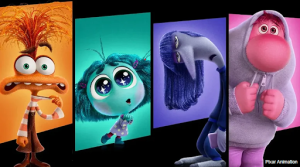In this blog, Áine (BioResource Undergraduate Placement Student 2024-2025) discusses the portrayal of anxiety in the movie Inside Out 2.
In recent years, the conversation around mental health has gained significant momentum, and animated films such as Inside Out 2 have been used to address emotionally complex themes in an accessible and appealing way. One of the emotions the movie introduces is Anxiety, which many audience members can relate to.
In this blog, we explore how anxiety is represented in the movie and how it compares to the way mental health disorders have traditionally been represented in the media. Interested readers can read more about anxiety in our other anxiety-related blogs here!
What is anxiety?
In the UK, more than 1 in 10 people – over 8 million individuals – are living with an anxiety disorder [1], reflecting a global trend where they are the most common mental health condition (affecting an estimated 18–20% of the population worldwide) [2]. With anxiety often beginning in childhood [3], if left untreated, it can take a chronic and unremitting course, persisting into adulthood [4]. Young people, especially women, are particularly vulnerable to anxiety [5]. Core symptoms of anxiety include extreme worry and fear as well as physical symptoms, such as increased heart rate and sweating. However, the way anxiety presents itself can vary depending on a person’s age; for example, children may show signs like clinginess, fear, constant crying, and stomach pains [3], while adults may experience intense worry and fear, lightheadedness, sweating, palpitations and restlessness [6]. Anxiety is an evolutionary response designed to protect us, but when it interferes with everyday life, it can significantly impact functioning and develop into an anxiety disorder [7]. Several factors, both genetic and environmental, can influence the development of anxiety [8]. Common psychosocial factors include childhood trauma, family history, and having a lower socio-economic environment [9].
What does the media portrayal of mental health look like?
Disney has previously referenced mental illness in 85% of its animated films, with 21% featuring main characters described as mentally ill, such as Maurice in Beauty and the Beast (referred to as ‘crazy’) and Jafar in Aladdin (Narcissistic Personality Disorder) [10]. Characters have been portrayed as notably more violent than people with mental health disorders in real life, and TV shows have widely used disrespectful slang terms such as ‘crazy’ and ‘insane’ to describe characters with mental illnesses [11]. Depicting mental health disorders in this way stigmatises the conditions and can often make those experiencing the disorders feel isolated.
However, Inside Out offers a fresh perspective on portraying mental health.
Inside Out 2
Inside Out (2015) and its sequel, Inside Out 2 (2024), follow a young girl, Riley, and the personified emotions in her mind in early childhood and adolescence, respectively. The first film explores five core emotions that are often experienced in early childhood, namely, Sadness, Joy, Fear, Disgust, and Anger. Inside Out 2 explores Riley’s emotions in adolescence as Riley, now 13, navigates the challenges of that age.
At the start of the second movie, Riley’s emotions are thrown into turmoil by a flashing light labelled “puberty,” signalling major changes. Four new emotions – Anxiety, Envy, Ennui (Boredom), and Embarrassment – emerge, complicating Riley’s emotional landscape and representing the emotional development that takes place in adolescence. A pivotal moment occurs in the movie when Anxiety arrives with a large suitcase, explaining her plans to keep Riley safe as she enters this new stage of her life, representing the idea of “emotional baggage” as unprocessed emotional issues [12], foreshadowing the chaos that Anxiety will bring throughout the film.
Below, we discuss how some core features of anxiety are portrayed in the movie.
Conditional thinking
One of the most relatable aspects of anxiety is something called conditional thinking – the belief that your worth depends on meeting certain expectations, like being successful, liked, or in control [13]. It is that quiet inner voice saying, “If I do well, then I’ll be okay,” which can lead people to suppress their true emotions to stay on track. Inside Out 2 captures this perfectly through the behaviours of Riley’s new emotion, Anxiety, who starts to steer her thoughts with beliefs like, “If I’m good at hockey, I’ll have friends.” This kind of thinking traps Riley in a cycle of pressure and emotional suppression, where expressing fear or doubt feels risky. Over time, the weight of these unspoken feelings builds up, leading to emotional overwhelm [14] – a reality that many people with anxiety know all too well.
Negative self-imagery and catastrophising
Negative self-imagery, or catastrophising, is another core characteristic of anxiety, which may often perpetuate anxiety symptoms [15]. This is further explored in Inside Out 2 when Anxiety convinces Riley she is “not good enough,” which damages her self-esteem. This occurs right before her chance to prove that she is capable of playing her sport in high school, leading to her doubting her talent and hard work, further allowing us to see how anxiety changes the way that we think about ourselves. In real life, negative self-imagery could be impairing and interfere with the everyday life of those experiencing symptoms. It also mirrors how anxiety can contribute to symptoms of depression or unhealthy coping mechanisms [16].
Somatic symptoms and panic attacks
Finally, experiencing physical sensations is another symptom of anxiety. These are known as somatic symptoms and may include chest and abdominal pain, headaches and fatigue, tachycardia and trembling [17]. In a later scene, we see Riley experience a panic attack, with her chest rising and falling, as she is sweating and dissociating. Illustrating these somatic symptoms helps viewers to understand the physical side of anxiety. Additionally, it helps both the audience and Riley to learn to recognise and manage panic attacks. By showing these symptoms, the scene emphasises that although panic attacks can be intense, they are manageable with proper techniques and awareness. Importantly, the film also hints at early steps in managing panic, such as recognising the signs, grounding through breath and objects (holding her hockey stick), and seeking support (through her friends), which can empower viewers to respond more calmly in real-life situations.
The film ends with Joy affirming, ”We love all of our girl; every messy, beautiful piece of her”, emphasising that anxiety does not diminish Riley’s worth – it is simply a part of who she is.
This reminds us that even though anxiety and all other emotions can feel incredibly overwhelming in a given moment, they do not define those who experience them.
Conclusion
In summary, historically, the media have perpetuated stigma surrounding mental health, associating it with rejection and isolation. In contrast, Inside Out 2 concludes with a positive and respectful message that helps to de-stigmatise anxiety. Despite Riley’s struggles with anxiety, she maintains her friendships and continues to play hockey, illustrating that mental health challenges do not define a person and should not dictate their lives. This portrayal helps highlight how we can identify when others may be struggling and support them. I believe the depiction of Anxiety in Inside Out 2 reflects parts of the condition in real life, such as the negative thought patterns and physical symptoms (dissociation and panic).
It is essential to remember that the way people experience poor mental health is varied, so although the film does not reflect the entirety of the condition, it depicts some core features of anxiety and can be a great tool for larger conversations about mental health. The way Inside Out 2 has approached anxiety is a good example of how the media can be used to help, rather than hinder, our understanding of these conditions.
References
- Mental Health UK. What is anxiety? – Mental Health UK [Internet]. Mental Health UK. 2019. Available from: https://mentalhealth-uk.org/help-and-information/conditions/anxiety-disorders/what-is-anxiety/
- Wu Y, Li X, Ji X, Ren W, Zhu Y, Chen Z, et al. Trends in the epidemiology of anxiety disorders from 1990 to 2021: A global, regional, and national analysis with a focus on the sociodemographic index. Journal of Affective Disorders [Internet]. 2024 Dec 26;373:166–74. Available from: https://www.sciencedirect.com/science/article/pii/S0165032724020743
- NHS. Anxiety disorders in children [Internet]. nhs.uk. 2020. Available from: https://www.nhs.uk/mental-health/children-and-young-adults/advice-for-parents/anxiety-disorders-in-children/
- Chiu A, Falk A, Walkup JT. Anxiety Disorders Among Children and Adolescents. FOCUS [Internet]. 2016 Jan;14(1):26–33. Available from: https://www.ncbi.nlm.nih.gov/pmc/articles/PMC6524434/
- Mental Health Foundation. Anxiety: statistics [Internet]. www.mentalhealth.org.uk. Mental Health Foundation; 2023. Available from: https://www.mentalhealth.org.uk/explore-mental-health/statistics/anxiety-statistics
- National Institute of Mental Health. Generalized anxiety disorder: When worry gets out of control [Internet]. National Institute of Mental Health. National Institute of Mental Health; 2022. Available from: https://www.nimh.nih.gov/health/publications/generalized-anxiety-disorder-gad
- Nesse RM. Anxiety Disorders in Evolutionary Perspective. Evolutionary Psychiatry [Internet]. 2022 Sep 29;101–16. Available from: https://deepblue.lib.umich.edu/bitstream/handle/2027.42/175862/Nesse%20Anxiety%20Disorders%20in%20Evolutionary%20Perspective%202022.pdf
- Craske MG, Stein MB, Eley TC, Milad MR, Holmes A, Rapee RM, et al. Anxiety disorders. Nature Reviews Disease Primers. 2017 May 4;3(1).
- NICE. CKS is only available in the UK [Internet]. NICE. 2024. Available from: https://cks.nice.org.uk/topics/generalized-anxiety-disorder/background-information/risk-factors/
- Lawson A, Fouts G. Mental Illness in Disney Animated Films. The Canadian Journal of Psychiatry [Internet]. 2004 May;49(5):310–4. Available from: https://journals.sagepub.com/doi/pdf/10.1177/070674370404900506
- Heather S. Media Portrayal of Mental Illness and Its Treatments: What Effect Does It Have on People With Mental Illness? [Internet]. CNS drugs. 2006. Available from: https://pubmed.ncbi.nlm.nih.gov/16478286/
- Gupta S. What Does the Term “Emotional Baggage” Mean? [Internet]. Verywell Mind. 2023. Available from: https://www.verywellmind.com/emotional-baggage-symptoms-causes-and-coping-strategies-6742778
- Proctor C. Conditions of Worth (Rogers). Encyclopedia of Personality and Individual Differences [Internet]. 2017;1(1):1–4. Available from: http://www.pprc.gg/wp-content/uploads/2017/03/Conditions-of-Worth.pdf
- Keyes KM, McLaughlin KA, Vo T, Galbraith T, Heimberg RG. ANXIOUS AND AGGRESSIVE: THE CO-OCCURRENCE OF IED WITH ANXIETY DISORDERS. Depression and Anxiety. 2015 Sep 30;33(2):101–11.
- Ng AS, Abbott MJ, Hunt C. The effect of self-imagery on symptoms and processes in social anxiety: A systematic review. Clinical Psychology Review. 2014 Dec;34(8):620–33.
- NHS. Raising low self-esteem [Internet]. NHS. 2023. Available from: https://www.nhs.uk/mental-health/self-help/tips-and-support/raise-low-self-esteem/
- Gelenburg AJ. Psychiatric and Somatic Markers of Anxiety. The Primary Care Companion to The Journal of Clinical Psychiatry. 2000 Apr 1;02(02):49–54.




